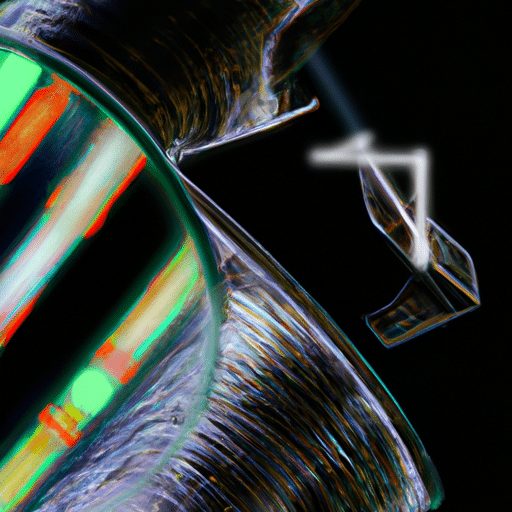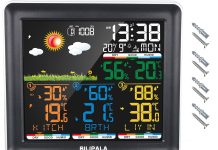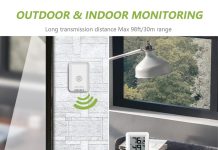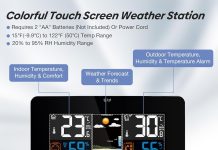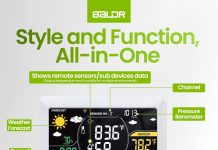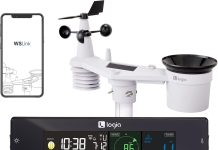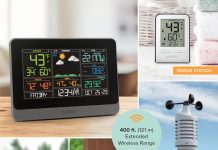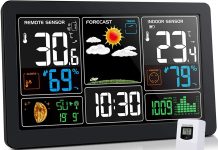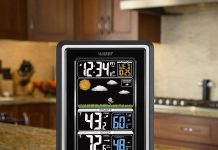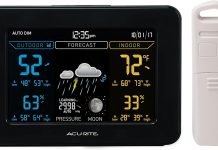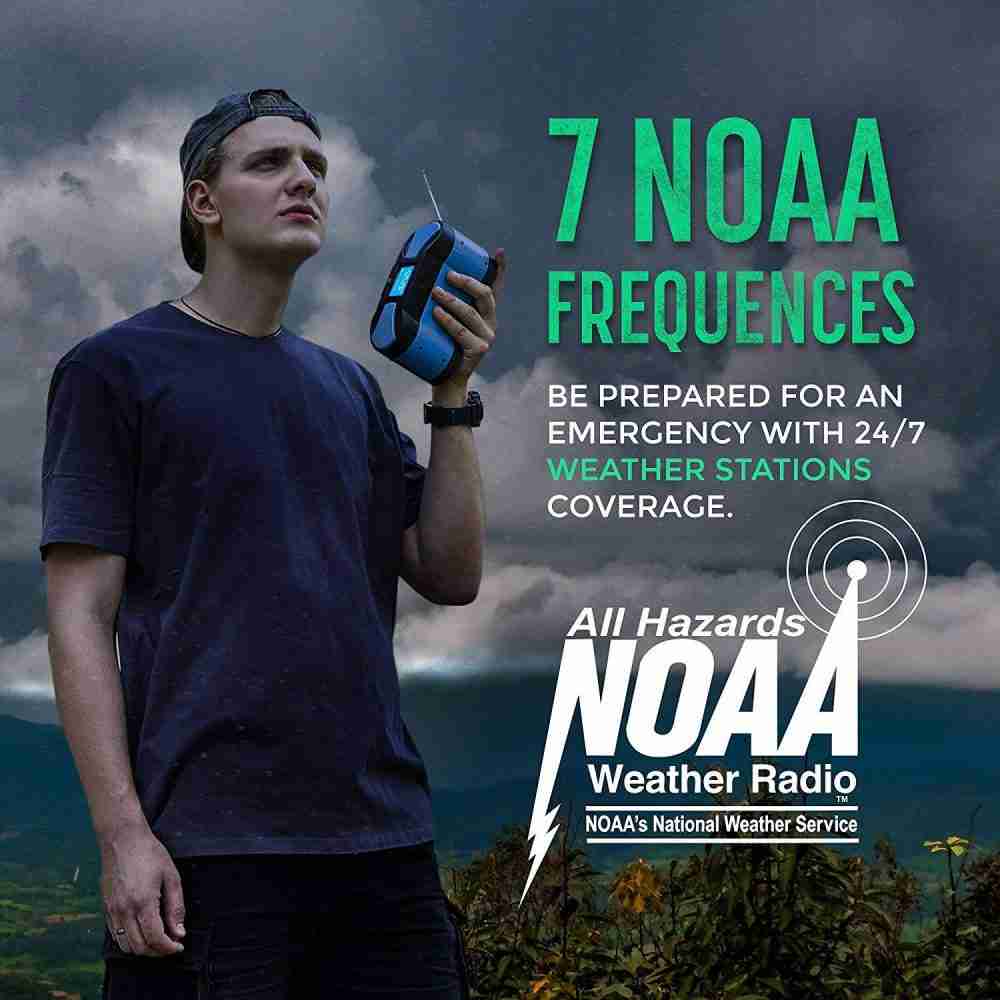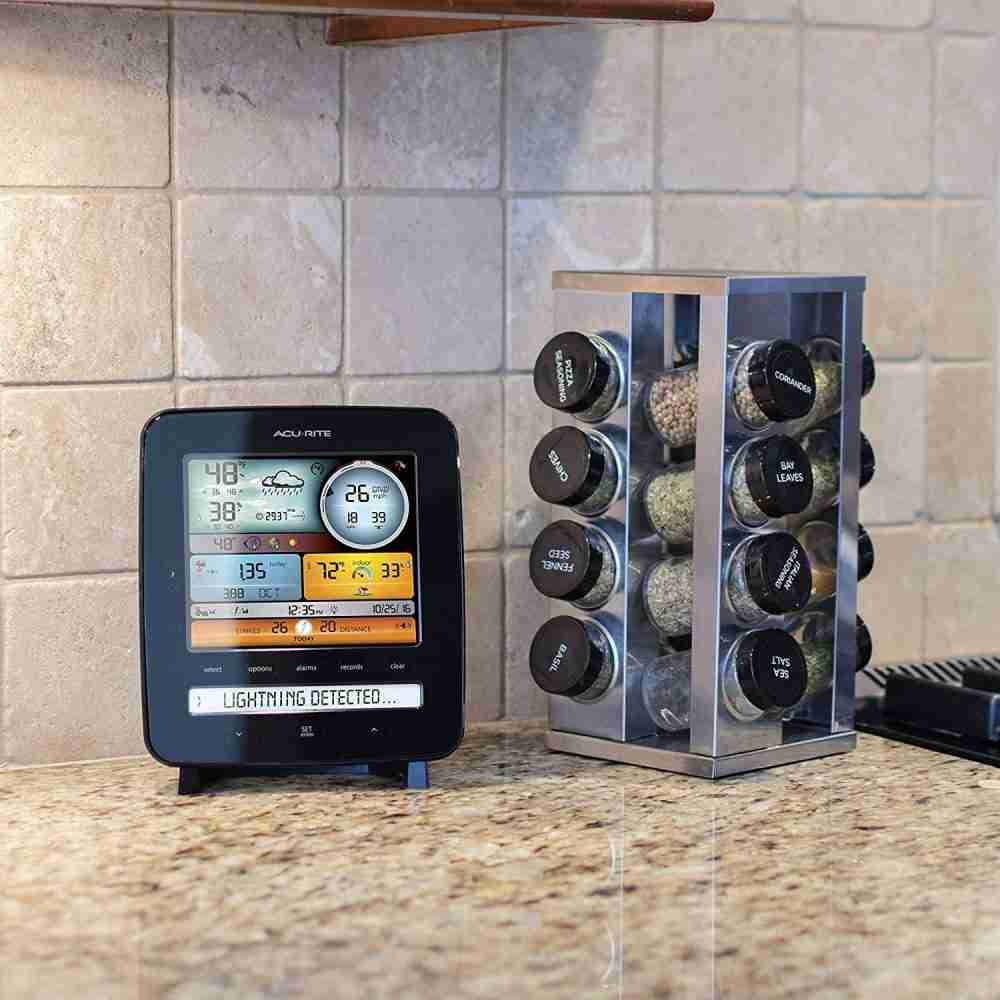In today’s fast-paced world, staying informed about the weather has become more essential than ever. We all want to know if we need an umbrella, if it’s going to be scorching hot, or if a storm is on its way. That’s where home weather stations come in handy. But have you ever wondered what exactly makes up these fascinating devices? In this article, we’ll explore the main components of a home weather station, giving you a closer look at the technology behind predicting the elements right from the comfort of your own backyard.
Weather Sensors
Weather sensors are the heart of a home weather station. They are responsible for measuring various environmental parameters that help us understand the current weather conditions. The following are the main types of weather sensors commonly found in home weather stations:
Temperature Sensor
The temperature sensor is a crucial component of a weather station. It measures the ambient temperature in degrees Celsius or Fahrenheit. This sensor allows us to determine whether it’s hot or cold outside, which is essential for planning outdoor activities and dressing appropriately. The accuracy of the temperature sensor is vital for reliable weather data.
Humidity Sensor
The humidity sensor measures the amount of moisture present in the air. It provides us with valuable information about the comfort level and helps predict the possibility of condensation or fog. By monitoring humidity levels, we can adjust our indoor environment to maintain optimal comfort. This sensor is especially significant for individuals with respiratory issues who may need to control humidity levels for health reasons.
Barometric Pressure Sensor
The barometric pressure sensor detects atmospheric pressure changes, which are closely related to weather patterns. By monitoring barometric pressure, we can anticipate changes in the weather, such as approaching storms or changes in air pressure associated with high or low-pressure systems. This sensor contributes to more accurate weather forecasting and allows us to plan outdoor activities accordingly.
Wind Speed and Direction Sensor
The wind speed and direction sensor measures the speed and direction of the wind. It is essential for understanding wind patterns and predicting upcoming weather conditions. By monitoring wind speed and direction, we can determine whether it’s a calm day or a windy one. This information is vital for activities like sailing, flying drones, or simply enjoying the outdoors.
Rain Gauge
The rain gauge measures the amount of precipitation that has fallen over a specific period. It helps us track rainfall trends and analyze precipitation patterns. Whether you’re a gardener, farmer, or simply interested in meteorology, the rain gauge is a valuable tool to understand how much water your plants are receiving and whether drought conditions are occurring.
Data Display and Control Unit
Once the weather sensors collect data, it needs to be displayed and managed effectively. The data display and control unit serve this purpose, providing us with a user-friendly interface to view and control our weather station.
LCD Display
The LCD display is the primary output interface of the weather station. It shows real-time weather data, including temperature, humidity, wind speed, barometric pressure, and rainfall. This display allows us to quickly glance at the current weather conditions without the need for additional devices or software.
Touchscreen Controls
To interact with the weather station and access various settings and features, touchscreen controls are commonly implemented. These touchscreens allow us to navigate through different menus, customize our weather station preferences, and control additional features such as alarms or notifications. The user-friendly touch interface simplifies the overall operation.
Data Logging and Storage
Data logging and storage functionality is important for analyzing weather trends over time. The weather station should have the capability to record and store data collected by the sensors at regular intervals. This allows us to review historical weather data and identify patterns or changes in the weather. Long-term data storage can be achieved through internal memory or external storage devices such as SD cards or cloud-based platforms.
Wireless Connectivity
In our increasingly connected world, wireless connectivity is a must-have feature in a home weather station. With wireless capabilities, the weather station can transmit data to a remote location, such as a smartphone, tablet, or computer. This allows us to monitor and access weather information from anywhere, providing convenience and flexibility. Additionally, wireless connectivity enables integration with other smart home devices or weather networks.
Power Source
A reliable power source is crucial to ensure continuous operation and accurate data collection in a home weather station. Different power options are available to cater to individual requirements and environmental conditions.
Battery
Battery power is a popular choice for portable and wireless weather stations. It allows the weather station to operate independently without the need for an external power source. Batteries can vary in size and type, such as rechargeable or replaceable alkaline batteries. The selection depends on the desired lifespan and power consumption of the weather station.
Solar Power
Solar power is an eco-friendly alternative to traditional power sources. Solar panels can be integrated into the weather station design and provide energy through sunlight. This power option is ideal for outdoor weather stations or areas with ample sunlight. Solar-powered weather stations reduce the reliance on batteries or other power sources and can be a sustainable choice.
AC Power
AC power is the most reliable power source as it ensures a continuous supply of electricity. Weather stations that use AC power are generally mounted in areas with access to electrical outlets. This power option eliminates the need for battery replacement or recharging and provides uninterrupted operation. However, it may limit the placement options for the weather station due to the proximity of power outlets.
Mounting and Installation
To maximize the accuracy and performance of a home weather station, proper mounting and installation are vital. The following considerations should be taken into account:
Indoor vs Outdoor Mounting
Deciding between indoor or outdoor mounting depends on the specific requirements and available space. Indoor mounting is suitable for individuals who prioritize convenience and plan to primarily monitor indoor conditions. Outdoor mounting allows for more accurate weather data collection but may require additional protection from the elements.
Mounting Options (Pole, Tripod, Wall)
Mounting options include poles, tripods, or wall brackets. Poles are commonly used for outdoor installations, providing sufficient height for sensors to capture unobstructed data. Tripods offer flexibility as they can be easily moved or adjusted to achieve optimal positioning. Wall brackets are ideal for indoor installations or locations with limited space, allowing the weather station to be securely mounted on a wall.
Installation Process
The installation process typically involves mounting the weather sensors, connecting them to the data display and control unit, and configuring any necessary settings. Detailed installation instructions should be provided with the weather station, ensuring ease and accuracy during setup. Some weather stations may require additional tools or expertise during installation, so it’s essential to follow the manufacturer’s guidelines.
Software and Mobile Applications
Weather station software and mobile applications enhance the functionality and user experience by providing additional features and data visualization capabilities.
Weather Station Software
Weather station software is usually included with the data display and control unit. It allows us to access more detailed weather data, perform data analysis, and customize settings. The software may provide historical data graphs, weather forecasting, and export options for further analysis. Additionally, software updates can enhance the performance and functionality of the weather station.
Mobile Applications
With the increasing use of smartphones and tablets, mobile applications have become popular for accessing weather station data remotely. These applications enable us to check real-time weather conditions, receive alerts, and customize settings directly from our mobile devices. Mobile applications also provide the convenience of accessing weather data on the go, ensuring that we can stay informed regardless of our location.
Data Visualization and Analysis
Weather station software and mobile applications often include data visualization and analysis features. These tools transform raw weather data into graphs, charts, or maps, presenting the information in a visually appealing and understandable format. Data visualization allows us to spot patterns, compare weather trends, and gain insights into the relationship between different weather parameters. This feature is particularly useful for proactive planning and exploring long-term weather patterns.
Internet Connectivity
Internet connectivity expands the capabilities and accessibility of a home weather station. It enables real-time data sharing, remote access, and integration with various online platforms and services.
Wi-Fi Connection
A Wi-Fi connection allows the weather station to connect to the local home network. This enables seamless data transfer to computers, tablets, or smartphones within the network. With Wi-Fi connectivity, weather data can be easily shared online, accessed remotely, or integrated with other smart home devices. Wi-Fi connectivity eliminates the need for physical connections, providing convenience and flexibility.
Ethernet Connection
For those who prefer a wired connection, an Ethernet connection can be used to connect the weather station to a router or modem. This connection ensures stable and reliable data transfer, especially in areas with weak or congested Wi-Fi networks. Ethernet connectivity is commonly found in professional-grade weather stations or installations where a wired connection is preferred.
Cellular Connection
Cellular connectivity is an excellent option for weather stations located in remote areas or without access to Wi-Fi or Ethernet networks. With a cellular connection, the weather station can transmit data directly to online platforms or services without the need for a local network. Cellular connectivity ensures data accessibility even in areas without traditional internet infrastructure.
Weather Forecasting
Accurate weather forecasting is an essential feature of a home weather station. It allows us to plan outdoor activities, prepare for upcoming weather changes, and stay informed about local weather conditions.
Weather Forecast Services
Weather forecast services provide up-to-date and localized weather predictions based on data from multiple sources. Weather stations can integrate with these services, allowing users to access forecasts directly from the data display and control unit or mobile applications. Depending on the weather station’s capabilities, forecasts may include information on temperature, precipitation, wind speed, and more.
Predictive Algorithms
Advanced weather stations utilize predictive algorithms to analyze historical data and forecast future weather patterns. These algorithms take into account factors such as temperature, humidity, barometric pressure, wind speed, and rainfall to generate accurate predictions. By continuously updating these algorithms with real-time data, weather stations can provide reliable short-term and long-term forecasts.
Historical Data Analysis
Weather stations record and store historical weather data, allowing us to conduct detailed analysis. By examining past weather patterns, we can identify trends, seasonal variations, and major weather events. This historical data analysis can help us make informed decisions regarding outdoor activities, gardening, or planning for specific weather conditions.
Maintenance and Calibration
Proper maintenance and calibration ensure the accuracy and longevity of a home weather station. Regular upkeep and calibration help maintain reliable and consistent weather data.
Maintenance Tips
Maintenance tips generally include cleaning the sensors, inspecting and replacing batteries if necessary, and examining the data display and control unit for any signs of damage. It is essential to follow the manufacturer’s recommendations for maintenance intervals and specific cleaning procedures to prevent any interference with sensor accuracy.
Calibration Techniques
Calibration techniques involve adjusting the weather station’s sensors to ensure accurate readings. Some weather stations provide automatic calibration features that compare sensor readings to known reference values. Manual calibration may involve following a step-by-step process provided by the manufacturer or using external calibration devices. Regular calibration helps maintain the integrity of the weather data collected by the sensors.
Sensor Cleaning
Sensor cleaning is crucial to remove any dust, debris, or contaminants that may impact accuracy. Regular cleaning of the sensors prevents interference with data collection and ensures reliable weather measurements. Cleaning procedures and recommendations vary depending on sensor type and manufacturer specifications. It’s important to handle sensors with care and follow the appropriate cleaning techniques to avoid damage.
Alarms and Notifications
Alarms and notifications enhance the functionality of a home weather station by providing real-time updates and alerts based on specific weather conditions.
Severe Weather Alerts
Severe weather alerts notify us of potentially dangerous weather conditions such as thunderstorms, floods, or tornadoes. When the weather station detects conditions that meet predefined criteria, it can trigger an alarm or send a notification. Severe weather alerts provide valuable warnings, allowing us to take necessary precautions and stay safe during extreme weather events.
Customizable Notifications
Customizable notifications allow us to select specific weather parameters for which we want to receive alerts. These notifications can be sent to our mobile devices, email, or even integrated with smart home systems. Customizable notifications provide flexibility and cater to individual preferences, ensuring that we’re informed about the weather conditions that matter most to us.
Integration with Smart Home Systems
Weather stations can integrate with smart home systems to enhance automation and convenience. For example, a weather station might trigger a notification to close outdoor window shades or adjust the thermostat based on the detected weather conditions. Integration with smart home systems creates a seamless and interconnected experience, allowing for customized responses to specific weather events.
Expandability and Additional Features
Many home weather stations offer expandability options and additional features that can enhance the overall weather monitoring experience.
Add-on Sensors and Accessories
Add-on sensors and accessories provide the opportunity to expand the capabilities of a weather station. These additional sensors can include UV index sensors, soil moisture sensors, or lightning detectors, to name a few. By adding specialized sensors, we can gather more specific environmental information and create a customized weather monitoring system that meets our unique needs.
Integration with Other Devices
Weather stations can integrate with other devices or services to further expand their functionality. For example, integration with voice assistants allows us to access weather information using voice commands. Weather data can also be shared or integrated with online platforms, home automation systems, or personal weather websites. Integration opens up possibilities for advanced data analysis, automation, and customization.
Multi-Station Network
For those interested in monitoring weather conditions across multiple locations, some weather stations support a multi-station network. This feature allows us to connect multiple weather stations to a single control unit or software interface. By monitoring weather data from various locations, we can gain insight into regional weather patterns and compare conditions between different areas.
In summary, a home weather station consists of various components that work together to collect, display, and analyze weather data. From weather sensors to data display units and connectivity options, each component plays a crucial role in providing accurate and timely weather information. By understanding the different components and their capabilities, we can choose a weather station that meets our specific needs and enhances our overall weather monitoring experience. Whether we are outdoor enthusiasts, gardeners, or simply weather enthusiasts, a home weather station can provide valuable insights into the changing weather conditions around us.

